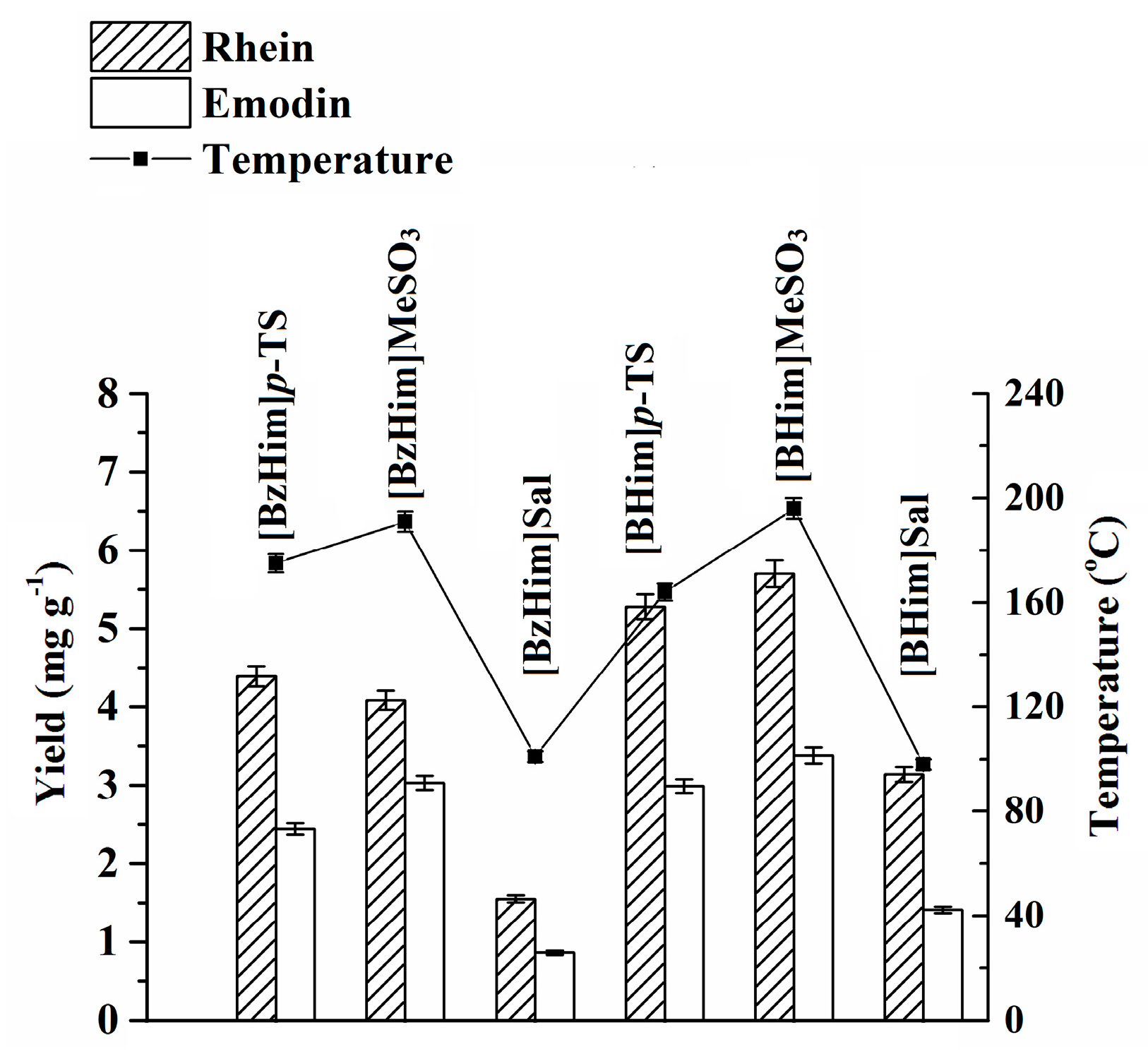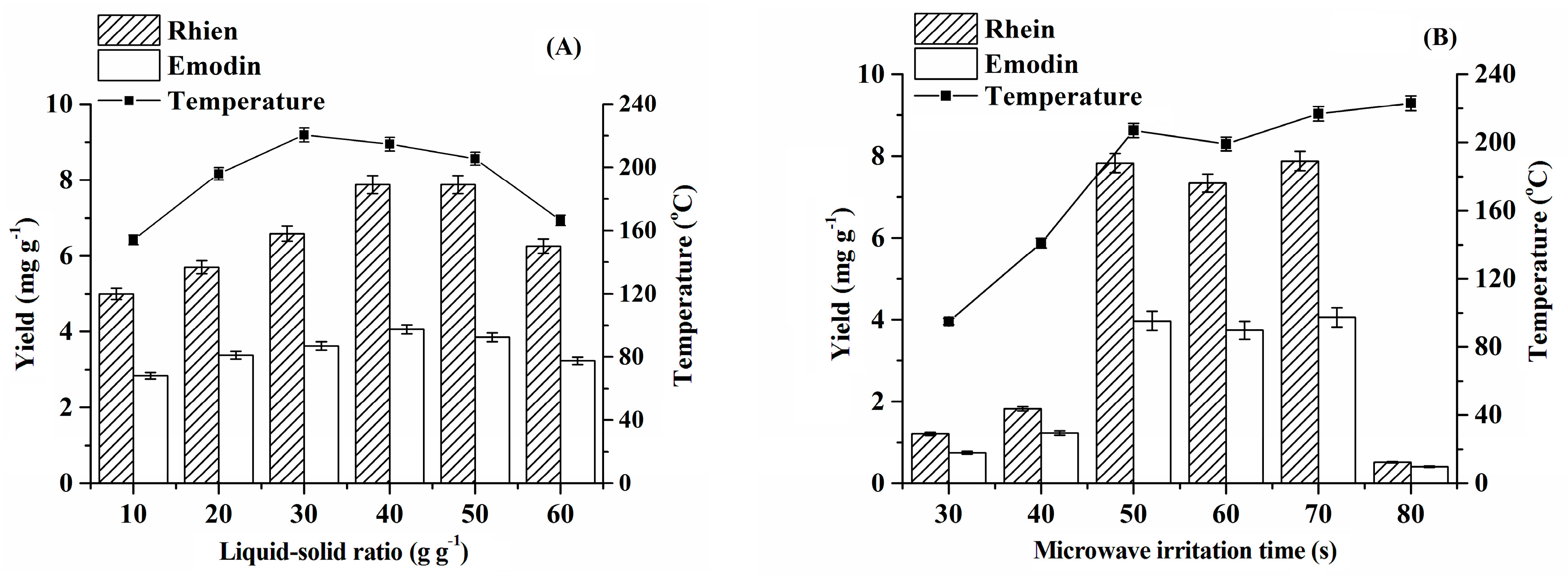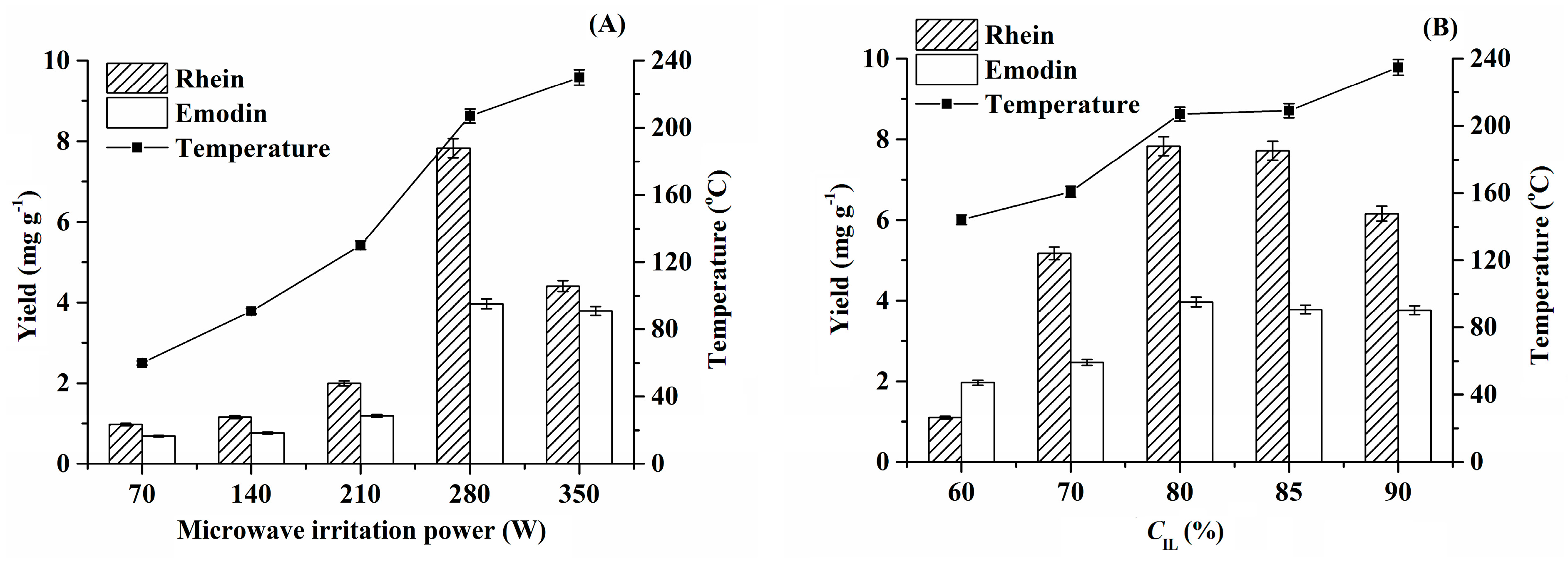Protic Ionic Liquids as Efficient Solvents in Microwave-Assisted Extraction of Rhein and Emodin from Rheum palmatum L.
Abstract
:1. Introduction
2. Results and Discussion
2.1. The Choice of PIL
2.2. Selection of Extraction Conditions
2.3. Comparison with Reported Methods
2.4. Recyclability of [BHim]MeSO3 and the Purification of Rhein and Emodin
3. Materials and Methods
3.1. Reagents
3.2. Synthesis of PILs
3.3. Microwave-Assisted Extraction (MAE)
3.4. Heat Reflux Extraction (HRE)
3.5. Ultrasound-Assisted Extraction (UAE)
4. Conclusions
Author Contributions
Funding
Conflicts of Interest
References
- Liu, Y.; Li, L.; Xiao, Y.Q.; Yao, J.Q.; Li, P.Y.; Yu, D.R.; Ma, Y.L. Global metabolite profiling and diagnostic ion filtering strategy by LC-QTOF MS for rapid identification of raw and processed pieces of Rheum palmatum L. Food Chem. 2016, 192, 531–540. [Google Scholar] [CrossRef] [PubMed]
- Aichner, D.; Ganzera, M. Analysis of anthraquinones in rhubarb (Rheum palmatum and Rheum officinale) by supercritical fluid chromatography. Talanta 2015, 144, 1239–1244. [Google Scholar] [CrossRef] [PubMed]
- Zhou, Y.; Zhang, J.; Tang, R.C.; Zhang, J. Simultaneous dyeing and functionalization of silk with three natural yellow dyes. Ind. Crops. Prod. 2015, 64, 224–232. [Google Scholar] [CrossRef]
- Khan, S.A.; Shahid-ul-Islam; Shahid, M.; Khan, M.I.; Yusuf, M.; Rather, L.J.; Khan, M.A.; Mohammad, F. Mixed metal mordant dyeing of wool using root extract of Rheum emodi (Indian Rhubarb/Dolu). J. Nat. Fibers 2015, 12, 243–255. [Google Scholar] [CrossRef]
- Huang, W.; Xue, A.; Niu, H.; Jia, Z.; Wang, J.W. Optimised ultrasonic-assisted extraction of flavonoids from Folium eucommiae and evaluation of antioxidant activity in multi-test systems in vitro. Food Chem. 2009, 114, 1147–1154. [Google Scholar] [CrossRef]
- Sun, C.; Liu, H.Z. Application of non-ionic surfactant in the microwave-assisted extraction of alkaloids from Rhizoma coptidis. Anal. Chim. Acta 2008, 612, 160–164. [Google Scholar] [CrossRef]
- Han, Y.; Yang, C.; Zhou, Y.; Han, D.; Yan, H. Ionic liquid–hybrid molecularly imprinted material–filter solid-Phase extraction coupled with HPLC for determination of 6-benzyladenine and 4-chlorophenoxyacetic acid in bean sprouts. J. Agric. Food Chem. 2017, 65, 1750–1757. [Google Scholar] [CrossRef]
- Liang, R.; Bao, Z.; Su, B.; Xing, H.; Yang, Q.; Yang, Y.; Ren, Q. Feasibility of ionic liquids as extractants for selective separation of vitamin D3 and tachysterol3 by solvent extraction. J. Agric. Food Chem. 2013, 61, 3479–3487. [Google Scholar] [CrossRef]
- Cao, Y.; Xing, H.; Yang, Q.; Bao, Z.; Su, B.; Yang, Y.; Ren, Q. Separation of soybean isoflavone aglycone homologues by ionic liquid-based extraction. J. Agric. Food Chem. 2012, 60, 3432–3440. [Google Scholar] [CrossRef]
- Khezeli, T.; Daneshfar, A.; Sahraei, R. A green ultrasonic-assisted liquid-liquid microextraction based on deep eutectic solvent for the HPLC-UV determination of ferulic, caffeic and cinnamic acid from olive, almond, sesame and cinnamon oil. Talanta 2016, 150, 577–585. [Google Scholar] [CrossRef]
- Amiri-Rigi, A.; Abbasi, S. Microemulsion-based lycopene extraction: Effect of surfactants, co-surfactants and pretreatments. Food Chem. 2016, 197, 1002–1007. [Google Scholar] [CrossRef] [PubMed]
- Pawłowska, B.; Feder-Kubis, J.; Telesiński, A.; Biczak, R. Biochemical responses of wheat seedlings on the introduction of selected chiral ionic liquids to the soils. J. Agric. Food Chem. 2019, 67, 3086–3095. [Google Scholar] [CrossRef] [PubMed]
- Tobiszewski, M.; Mechlinska, A.; Namiesnik, J. Green analytical chemistry—Theory and practice. Chem. Soc. Rev. 2010, 39, 2869–2878. [Google Scholar] [CrossRef] [PubMed]
- Prat, D.; Pardigon, O.; Flemming, H.W.; Letestu, S.; Ducandas, V.; Isnard, P.; Guntrum, E.; Senac, T.; Ruisseau, S.; Cruciani, P.; et al. Sanofi’s solvent selection guide: A step toward more sustainable processes. Org. Process Res. Dev. 2013, 17, 1517–1525. [Google Scholar] [CrossRef]
- Procopio, A.; Alcaro, S.; Nardi, M.; Oliverio, M.; Ortuso, F.; Sacchetta, P.; Sindona, G. Synthesis, biological evaluation, and molecular modeling of oleuropein and its semisynthetic derivatives as cyclooxygenase inhibitors. J. Agric. Food Chem. 2009, 57, 11161–11167. [Google Scholar] [CrossRef] [PubMed]
- Nardi, M.; Bonacci, S.; Cariati, L.; Costanzo, P.; Oliverio, M.; Sindona, G.; Procopio, A. Synthesis and antioxidant evaluation of lipophilic oleuropein aglycone derivatives. Food Funct. 2017, 8, 4684–4692. [Google Scholar] [CrossRef] [PubMed]
- Nardi, M.; Bonacci, S.; De Luca, G.; Maiuolo, J.; Oliverio, M.; Sindona, G.; Procopio, A. Biomimetic synthesis and antioxidant evaluation of 3,4-DHPEA-EDA [2-(3,4-hydroxyphenyl) ethyl (3S, 4E)-4-formyl-3-(2-oxoethyl)hex-4-enoate]. Food Chem. 2014, 162, 89–93. [Google Scholar] [CrossRef] [PubMed]
- Wu, Y.C.; Wu, P.; Li, Y.B.; Liu, T.C.; Zhang, L.; Zhou, Y.H. Natural deep eutectic solvents as new green solvents to extract anthraquinones from Rheum palmatum L. RSC Adv. 2018, 8, 15069–15077. [Google Scholar] [CrossRef]
- Dai, Y.; van Spronsen, J.; Witkamp, G.J.; Verpoorte, R.; Choi, Y.H. Natural deep eutectic solvents as new potential media for green technology. Anal. Chim. Acta 2013, 766, 61–68. [Google Scholar] [CrossRef]
- Wei, Z.F.; Wang, X.Q.; Peng, X.; Wang, W.; Zhao, C.J.; Zu, Y.G.; Fu, Y.J. Fast and green extraction and separation of main bioactive flavonoids from Radix Scutellariae. Ind. Crops Prod. 2015, 63, 175–181. [Google Scholar] [CrossRef]
- Wang, S.Y.; Yang, L.; Zu, Y.G.; Zhao, C.J.; Sun, X.W.; Zhang, L.; Zhang, Z.H. Design and performance evaluation of ionic-liquids-based microwave-assisted environmentally friendly extraction technique for camptothecin and 10-hydroxycamptothecin from Samara of Camptotheca acuminata. Ind. Eng. Chem. Res. 2011, 50, 13620–13627. [Google Scholar] [CrossRef]
- Chi, Y.; Zhang, Z.; Li, C.; Liu, Q.; Yan, P.; Welz-Biermann, U. Microwave-assisted extraction of lactones from Ligusticum chuanxiong Hort. using protic ionic liquids. Green Chem. 2011, 13, 666–670. [Google Scholar]
- Greaves, T.L.; Drummond, C.J. Protic ionic liquids: Properties and applications. Chem. Rev. 2008, 108, 206–237. [Google Scholar] [CrossRef] [PubMed]
- Hu, H.; Yang, H.; Huang, P.; Cui, D.; Peng, Y.; Zhang, J.; Lu, F.; Lian, J.; Shi, D. Unique role of ionic liquid in microwave-assisted synthesis of monodisperse magnetite nanoparticles. Chem. Commun. 2010, 46, 3866–3868. [Google Scholar] [CrossRef] [PubMed]
- Arsalani, N.; Zare, P.; Namazi, H. Solvent free microwave assisted preparation of new telechelic polymers based on poly(ethylene glycol). Express Polym. Lett. 2009, 3, 429–436. [Google Scholar] [CrossRef]
- Yang, F.; Gong, J.; Yang, E.; Guan, Y.; He, X.; Liu, S.; Zhang, X.; Deng, Y. Microwave-absorbing properties of room-temperature ionic liquids. J. Phys. D Appl. Phys. 2019, 52, 155302. [Google Scholar] [CrossRef]
- Spange, S.; Lungwitz, R.; Schade, A. Correlation of molecular structure and polarity of ionic liquids. J. Mol. Liq. 2014, 192, 137–143. [Google Scholar] [CrossRef]
- Chen, S.; Izgorodina, E.I. Prediction of 1H NMR chemical shifts for clusters of imidazolium-based ionic liquids. Phys. Chem. Chem. Phys. 2017, 19, 17411–17425. [Google Scholar] [CrossRef]
- Lin, S.T.; Ding, M.F.; Chang, C.W.; Lue, S.S. Nuclear magnetic resonance spectroscopic study on ionic liquids of 1-alkyl-3-methylimidazolium salts. Tetrahedron 2004, 60, 9441–9446. [Google Scholar] [CrossRef]
- Zhao, L.C.; Liang, J.; Li, W.; Cheng, K.M.; Xia, X.; Deng, X.; Yang, G.L. The use of response surface methodology to optimize the ultrasound-assisted extraction of five anthraquinones from Rheum palmatum L. Molecules 2011, 16, 5928–5937. [Google Scholar] [CrossRef]
- Chinese Pharmacopoeia Commission. Pharmacopoeia of the People’s Republic of China, 10th ed.; Medical Science and Technology Press: Beijing, China, 2015; p. 23. [Google Scholar]
Sample Availability: Samples of the compounds are available from the authors. |




| Extraction Method | Extraction Time | Content (mg∙g−1) | |
|---|---|---|---|
| Rhein | Emodin | ||
| UAE/LGH a | 1.5 h | 1.6 | 1.4 |
| UAE/84% methanol b | 33 min | 1.9 | 1.1 |
| HRE/methanol–trichloromethane c | 2 h | 7.3 | 3.5 |
| MAE/LGH d | 50 s | 2.2 | 0.87 |
| MAE/80% [BHim]MeSO3 e | 50 s | 7.8 | 4.0 |
© 2019 by the authors. Licensee MDPI, Basel, Switzerland. This article is an open access article distributed under the terms and conditions of the Creative Commons Attribution (CC BY) license (http://creativecommons.org/licenses/by/4.0/).
Share and Cite
Fan, Y.; Niu, Z.; Xu, C.; Yang, L.; Yang, T. Protic Ionic Liquids as Efficient Solvents in Microwave-Assisted Extraction of Rhein and Emodin from Rheum palmatum L. Molecules 2019, 24, 2770. https://doi.org/10.3390/molecules24152770
Fan Y, Niu Z, Xu C, Yang L, Yang T. Protic Ionic Liquids as Efficient Solvents in Microwave-Assisted Extraction of Rhein and Emodin from Rheum palmatum L. Molecules. 2019; 24(15):2770. https://doi.org/10.3390/molecules24152770
Chicago/Turabian StyleFan, Yunchang, Zeyu Niu, Chen Xu, Lei Yang, and Tuojie Yang. 2019. "Protic Ionic Liquids as Efficient Solvents in Microwave-Assisted Extraction of Rhein and Emodin from Rheum palmatum L." Molecules 24, no. 15: 2770. https://doi.org/10.3390/molecules24152770
APA StyleFan, Y., Niu, Z., Xu, C., Yang, L., & Yang, T. (2019). Protic Ionic Liquids as Efficient Solvents in Microwave-Assisted Extraction of Rhein and Emodin from Rheum palmatum L. Molecules, 24(15), 2770. https://doi.org/10.3390/molecules24152770






